
After more than a decade of brutal fighting and over 20,000 casualties, Mexico officially gained its independence from Spain on September 27, 1821. This moment marked the end of three centuries of Spanish rule. The road to independence, however, was long, complicated, and filled with both triumphs and setbacks.
Spain had controlled Mexico since 1521, when Spanish conquistador Hernán Cortés defeated the Aztec Empire and claimed the territory for Spain. For centuries, Spain governed Mexico as a colony and extracted wealth through mining and agriculture, while enforcing a rigid social hierarchy that favored Spaniards born in Europe. People born in Mexico of Spanish ancestry, called creoles, had limited power compared to their European counterparts, and Indigenous and mixed-race people were often treated as second-class citizens. For many years, this system remained mostly unchallenged. But by the early 1800s, events in Europe changed everything.
In 1808, Napoleon Bonaparte invaded Spain and forced King Ferdinand VII to abdicate the throne. This left Spanish colonies across the Americas in political turmoil, creating an opportunity for independence movements to rise. In Mexico, the push for independence began with a priest named Miguel Hidalgo y Costilla.
On the night of September 15–16, 1810, Hidalgo rang the church bells in the town of Dolores and called for an uprising against Spanish authorities. This historic speech became known as the Grito de Dolores, or “Cry of Dolores,” and is celebrated every year as the start of Mexico’s War of Independence. By morning, Hidalgo had gathered a growing army of Indigenous peasants and mestizos (people of mixed Indigenous and European heritage) who were determined to overthrow Spanish rule.
The rebel army marched to Guanajuato, an important mining city controlled by Spaniards and creoles loyal to the crown. The defenders barricaded themselves inside the city’s granary, but the rebels stormed the building on September 28, capturing it and killing or exiling most of those inside. This victory was a major early success for the independence movement, but it also shocked the Spanish authorities and convinced them to strike back hard.

Just a month later, on October 30, Hidalgo’s forces fought the Spanish army at the Battle of Monte de las Cruces. Although the rebels initially gained ground, they were unable to take Mexico City. Many survivors were forced to retreat and go into hiding. The movement suffered another devastating blow in January 1811, when Spanish troops defeated the rebels at the Battle of the Bridge of Calderón. Hidalgo and several other leaders attempted to flee toward the US-Mexico border but were captured, put on trial, and executed later that year.
Despite the loss of Hidalgo, the fight for independence did not end. Leadership passed to José María Morelos, another Catholic priest and skilled military commander. Under Morelos, the rebels regrouped and captured key cities, including Oaxaca and the important port of Acapulco. In 1813, Morelos convened the Congress of Chilpancingo, where revolutionary leaders drafted a constitution and signed the Solemn Act of the Declaration of Independence of Northern America on November 6, formally declaring Mexico’s independence.

Unfortunately, Morelos was captured in 1815 and executed by Spanish forces, leaving the independence movement leaderless once again. For the next several years, small groups of guerrilla fighters kept the cause alive, slowly wearing down Spanish control.
Finally, in 1821, the independence movement found success under the leadership of Agustín de Iturbide and Vicente Guerrero, who united royalist and rebel forces under the Plan of Iguala. This agreement promised independence, equality between Spaniards and creoles, and the protection of Catholicism. On September 24, 1821, Spanish representatives signed the Treaty of Córdoba, officially recognizing Mexico’s independence. Three days later, the Army of the Three Guarantees triumphantly entered Mexico City, bringing an end to 11 years of conflict and establishing Mexico as a free and independent country.
Click here for more Mexico stamps.
| FREE printable This Day in History album pages Download a PDF of today’s article. Get a binder or other supplies to create your This Day in History album. |
Discover what else happened on This Day in History.


This vignette is just like all of the ones that Mystic sends–excellent! I wish you were around when I started collecting, but that was in 1940! I hope you can keep it up indefinitely. There is still a lot of history I don’t know and you make it easy.
Great info once again–thank you these tidbits of history!
I am growing to really like this program. It is becoming my ‘stamp and coffee’ moment to start the day. Thanks. …however, today, while ‘really’ looking at a stamp that I’ve seen before I wondered… What’s the deal on the artwork? How about maybe a sidebar on the story of the art… I don’t mind starting the day with two cups of coffee.
I agree, I always though that the best way to teach history is with stamps, I enjoy the morning brief with coffee each day as well.
Love the Day In History! They are educational and extremely interesting.
Thank you
Sadly the independence from Spain was followed by a series of dictators. There was however, the establishment of the Constitution of 1824. It provided for local and state representation by vote and slavery was forbidden. But Antonio Lopez de Santa Anna t made himself the Napolean of the West taking away that representation in the States and appointing military governors. Texas would eventually revolt, as would Yucatan. But that’s another story for another stamp.
intresting story ,, one on the alamo would fit in ..
I went to college ( Mexico City College ) from the Fall of 1956 to June, 1961 when I
graduated……..I lived with a Mexican family the first year , just off the Paseo de la Reforma
one of the most beautiful boulevards, I thought and still do, in the world……….I was joined
by 200 or more ex-GI’s from the Korean War as I was……..I do not recall any bad feelings
we ever encountered from the Mexican people…and a number of us married Mexican women.. there are millions of people there now and it is not as it was..those many years ago when I attended college there………….
I have been back few times but will not return again………..to dangerous……………..
A pity that you do not mention Gen. Agustin de Iturbide who was the one person who could end the war without firing a shot and gain the Independence for Mexico on September 27th, 1821. After making an alliance with Vicente Guerrero in the Abrazo de Acatempan (Scott 632) he went to Cordoba to receive the incoming Viceroy from Spein and negotiated with him the end of the war without the loss of one life, formalizing the Treaty of Cordoba, then he marched into Mexico City in front of the Insurgent Army (Scott 633). Unfortunately the official history as told by the government has tried to forget about the true liberator of Mexico.
This information was added.
Thank you for this information I am going to do use this information for my school project-Danny
Very happy to read and learn about some universal history chapters….many times forgotten.
Morelos was a great and brave man along many others!!!
I’ve love the artwork on my stamps. The history info is very important to me. Thank you for the daily history lesson. K
Thanks for the work you are putting into the daily. You people rock. K
WOW!! What a great site!!! Every day I check my NASA website to check up on the latest info about what’s happening out there in space. Now I’m going to add this website to my daily dose of information. I’ve been collecting stamps ever since 1952 while I was in college. This will be my way to check up on what’s has happened in the past. Thanks a mil!!!